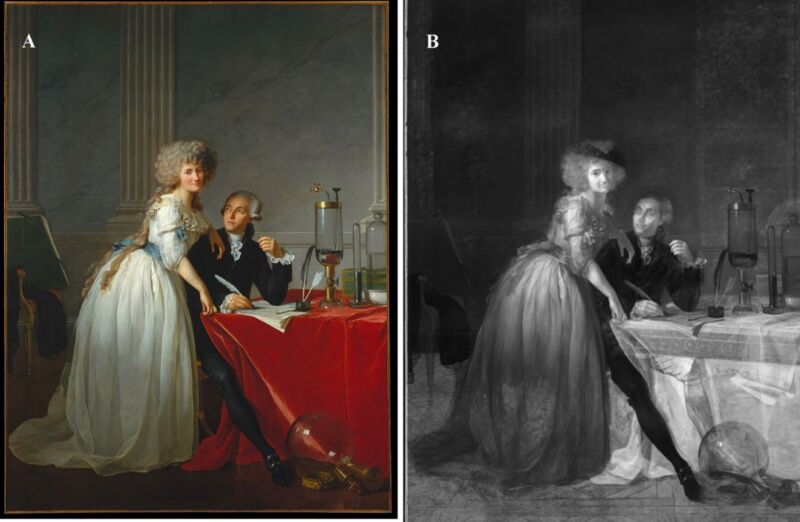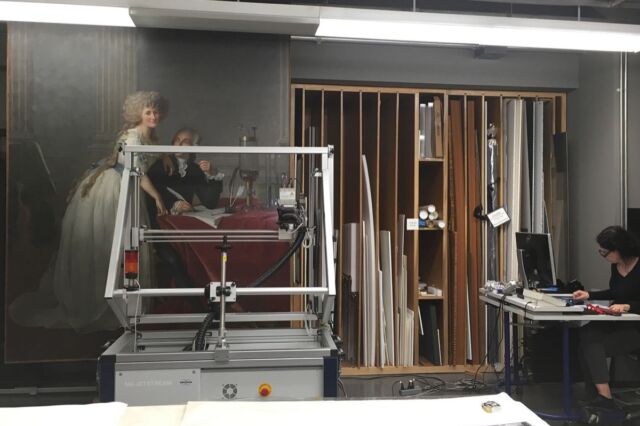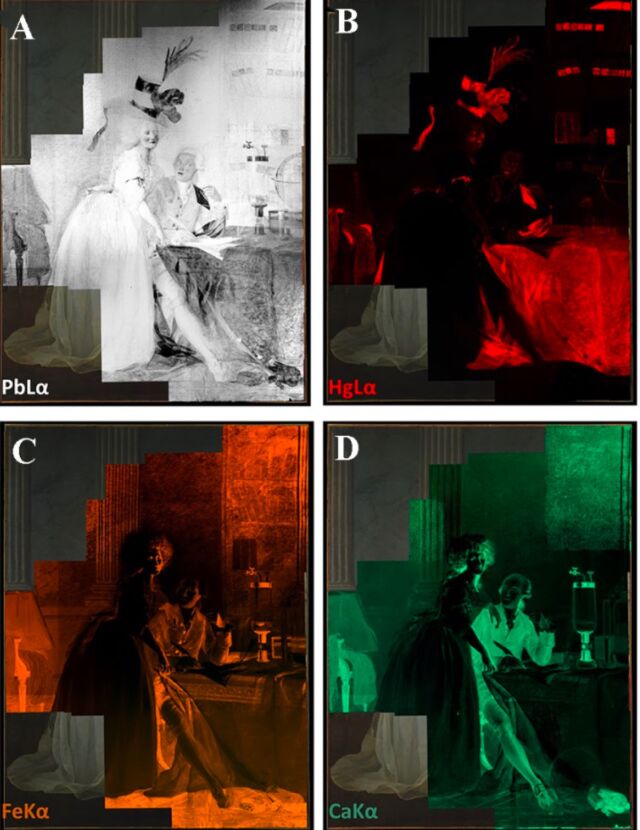Micro X-rays mark the spot(s) —
Painting was likely altered to appease growing French anti-aristocratic sentiment.
Jennifer Ouellette
–

The French 18th-century chemist Antoine Lavoisier is a complicated historical figure. Scientifically, of course, he is an undisputed giant, helping usher in the chemical revolution as the field shifted from a qualitative to a quantitative approach, among many other achievements. He was also a wealthy nobleman and tax collector for the Ferme Generale, one of the most hated bodies of the Ancien regime as the French Revolution gained momentum. Those activities added to his fortune, which he used to fund his (and others’) scientific research and to foster public education. But it’s also why he ran afoul of the revolutionaries in power during the infamous Reign of Terror; they beheaded both Lavoisier and his father-in-law on the same day in 1794 as “enemies of the people.”
Something of that complexity is evident in a new scientific analysis of the famous 1788 portrait, now housed in the Metropolitan Museum of Art in New York, of Lavoisier and his wife, Marie-Anne, by the Neoclassical painter Jaques-Louis David. The painting shows husband and wife posing with a collection of small scientific instruments—a tribute to their intellectual endeavors.
But cutting-edge analysis techniques have revealed that David originally painted a different version, without the scientific accoutrements, depicting the couple as more typical French aristocrats. He cleverly obscured the underpainting in the final portrait, most likely in response to the growing backlash against the aristocracy, according to a recent paper published in the journal Heritage Science. As the authors wrote in an accompanying online article for the Met:
In addition to modifications of existing formats and poses popular in 1780s portraiture, the overall development of the Lavoisiers’ portrait moved away from foregrounding their identity as tax collectors (the source of their fortune that allowed for such a luxurious commission) and toward underscoring their scientific work. It is, of course, the latter identity that is so clearly defined today and has helped perpetuate their fame both in art history and the history of science. But another identity has been quite literally concealed in the present portrait, and its revelation offers an alternate lens for apprehending Lavoisier not for his contributions to science but simply a wealthy tax collector who could afford the whims of fashionable dress and portraiture that sent him to the guillotine in 1794.

Enlarge / Research scientist Silvia A. Centeno acquiring X-ray fluorescence maps of David’s portrait of the Lavoisiers.
Antoine Lavoisier’s marriage to Marie-Anne Paulze—the daughter of Jacques Paulze, a colleague at the Ferme Generale—was actually arranged by the bride’s father. Apparently, a much older count wanted to marry the 13-year-old Marie-Anne, and Paulze couldn’t outright refuse without losing his job. So he persuaded the 28-year-old Lavoisier to propose instead. Marie-Anne proved to be an excellent choice and took an active interest in her husband’s scientific work. She became an excellent laboratory assistant, making sketches of his experiments, translating English scientific texts into French, and helping maintain meticulous records of the procedures used. She was also a charming hostess for the couple’s scientific soirées.
David was one of the most pre-eminent painters of this period, equally renowned in his field as Lavoisier was in science. David tutored Marie-Anne Lavoisier, enabling her to accurately sketch her husband’s various experiments, and was a guest at chez Lavoisier on several occasions. So naturally, the couple commissioned him to paint their portrait. The finished product is considered a landmark of neoclassical portraiture. The Lavoisiers appear to be the very model of “a modern scientifically minded couple in fashionable but simple dress, their bodies casually intertwined,” the authors wrote in their accompanying article.
David’s portrait is remarkably well-preserved, which is perhaps why nobody suspected the existence of an underpainting until 2019, when the piece arrived in the laboratory of conservator Dorothy Mahon after a curator noticed some degradation in the surface varnish. Before she could remove the varnish, Mahon had to analyze the painting quite closely under a microscope to make sure any solvent mixture she used would protect the painting and not put her own health at risk.
That’s when she noticed bits of red paint peeking out in the area above Marie-Anne’s head and through the blue ribbons and bows on her dress. Mahon also noted dried cracks around the red tablecloth in the painting’s foreground. Clearly, a closer analysis was warranted.

Enlarge / Elemental distribution maps acquired by MA-XRF on the portrait of Antoine-Laurent and Marie-Anne Pierrette Paulze Lavoisier: lead, (A); mercury (B); iron (C); and calcium (D).
S.A. Centeno et al./Heritage Science, 2021
As Silvia Centeno et al. point out in their paper, much of the technology this interdisciplinary team used to examine the painting is fairly recent and would not have been available to them when the Met acquired the painting in 1977 from the Rockefeller Institute for Medical Research. First, the researchers used infrared reflectography (IRR) to peer through the upper layers of paint. A specialized camera enabled the imaging of the entire nine-foot-by-six-foot canvas. The resulting reflectogram showed evidence of a carbon-based black underdrawing and dark, unclear shapes hinting at possible significant compositional changes.
Next, the researchers employed macro X-ray fluorescence imaging (MA-XRF) to map out the distribution of elements in the paint pigments—including the paint used below the surface. That process took some 270 hours and produced a huge amount of data. It was Centeno’s expertise, supplemented with chemical analysis of tiny paint samples, that enabled the team to create detailed elemental maps for further study.
